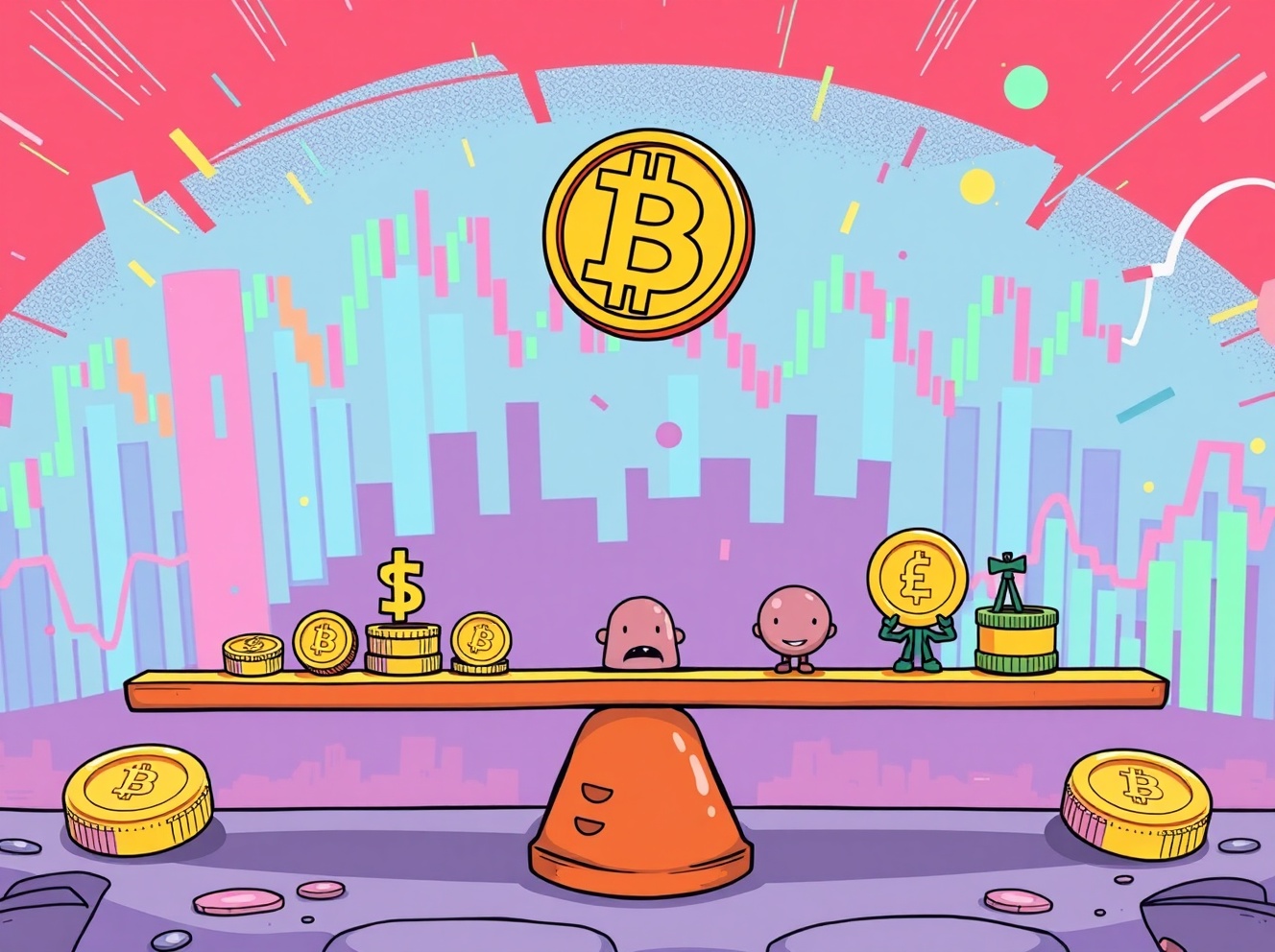Altcoin Season Index Plummets: A Crucial Warning for Crypto Investors
BitcoinWorld
Altcoin Season Index Plummets: A Crucial Warning for Crypto Investors
The cryptocurrency world is buzzing with a significant shift: the Altcoin Season Index has just taken a noticeable dip, falling to 48. This isn’t just a number; it’s a crucial signal for every investor navigating the volatile digital asset landscape. What does this six-point drop from 54 mean for your portfolio, and are we heading into a Bitcoin-dominated period?
What Does the Altcoin Season Index Truly Tell Us?
Understanding the Altcoin Season Index is essential for making informed decisions in the crypto market. This invaluable indicator, provided by CoinMarketCap, offers a clear snapshot of market sentiment by comparing the performance of major altcoins against Bitcoin.
- It tracks the price performance of the top 100 cryptocurrencies by market capitalization.
- Stablecoins and wrapped coins are intentionally excluded to focus purely on speculative asset performance.
- The comparison is made against Bitcoin’s performance over the last 90 days.
A score closer to 100 indicates a strong altcoin season, where a significant majority of altcoins are outperforming Bitcoin. Conversely, a lower score, especially below 25, typically signals a ‘Bitcoin Season,’ where the market leader is dominating.
Why Did the Altcoin Season Index Experience a Dramatic Fall?
The recent six-point decline in the Altcoin Season Index, from 54 to 48, points to a clear shift in market dynamics. Several factors often contribute to such movements, reflecting the complex interplay of investor sentiment and market forces.
- Bitcoin’s Strength: Often, a strong rally in Bitcoin can pull capital away from altcoins, as investors consolidate holdings in the market leader.
- Profit-Taking: After periods of altcoin outperformance, investors may take profits, converting altcoins back into Bitcoin or stablecoins.
- Macroeconomic Factors: Broader economic uncertainties can lead investors to seek perceived safer assets, and in crypto, Bitcoin often plays this role.
This drop suggests that fewer than 75% of the top 100 altcoins are currently outperforming Bitcoin over the past 90 days, indicating a potential cooling off for the broader altcoin market.
Navigating the Shifting Tides: What Should Investors Do?
A falling Altcoin Season Index doesn’t necessarily spell doom for all altcoins, but it does signal a time for strategic re-evaluation. For astute investors, this period can present unique opportunities to adjust portfolios and mitigate risks.
Consider these actionable insights:
- Re-evaluate your portfolio: Assess which altcoins still have strong fundamentals and long-term potential, regardless of short-term market fluctuations.
- Risk Management: This might be a time to reduce exposure to highly speculative altcoins and increase holdings in more established assets or stablecoins.
- Research is Key: Dive deeper into projects. Strong technology, active development, and genuine utility can help altcoins weather a Bitcoin-dominant phase.
This decline in the Altcoin Season Index could be a moment to pivot your strategy, focusing on resilience and value.
Understanding Crypto Market Cycles Beyond the Altcoin Season Index
While the Altcoin Season Index is a powerful tool, it’s crucial to remember that it’s just one indicator within a larger, dynamic market. Cryptocurrency markets operate in cycles, and understanding these broader trends can provide a more comprehensive perspective.
Market cycles typically involve:
- Accumulation phases: Smart money buys in.
- Bull runs: Prices surge, driven by FOMO.
- Distribution phases: Profits are taken.
- Bear markets: Prices decline, often with capitulation.
The index helps pinpoint specific moments within these cycles, but it doesn’t predict the entire market’s future. It simply reflects the current performance relationship between altcoins and Bitcoin.
Strategies for a Bitcoin-Dominant Period
When the Altcoin Season Index indicates a shift towards Bitcoin dominance, it doesn’t mean altcoins are dead. Instead, it encourages a different approach to investment. Patience and strategic positioning become paramount.
Here are some strategies to consider:
- Dollar-Cost Averaging (DCA): Continue to invest small, regular amounts into promising altcoins to average out your purchase price.
- Focus on Fundamentals: Prioritize altcoins with strong use cases, solid teams, and robust communities. These projects are more likely to recover and thrive in the long run.
- Diversification: While altcoins might be struggling, ensure your portfolio is balanced, perhaps with a higher allocation to Bitcoin or Ethereum during such times.
This period can be an excellent opportunity for long-term investors to accumulate quality assets at potentially lower prices.
Conclusion: A Crucial Indicator for Astute Investors
The recent drop in the Altcoin Season Index to 48 is a clear signal that market dynamics are shifting. While it suggests a cooling period for many altcoins relative to Bitcoin, it also underscores the importance of staying informed and adaptable. For savvy investors, understanding these indicators is not about panic, but about making strategic, data-driven decisions. By paying attention to the Altcoin Season Index and broader market trends, you can better position your portfolio to navigate the exciting, yet often volatile, world of cryptocurrencies.
Frequently Asked Questions (FAQs)
1. What is the Altcoin Season Index?
The Altcoin Season Index is a metric that tracks the performance of the top 100 cryptocurrencies (excluding stablecoins and wrapped coins) against Bitcoin over the past 90 days. It helps indicate whether altcoins or Bitcoin are currently dominating the market.
2. How is an altcoin season officially defined by the index?
An altcoin season is officially signaled when 75% of the top 100 altcoins (excluding stablecoins and wrapped coins) outperform Bitcoin during the 90-day period.
3. What does a score of 48 on the Altcoin Season Index mean?
A score of 48 means that less than 75% of the top 100 altcoins have outperformed Bitcoin over the last 90 days. It suggests that the market is currently not in an altcoin season, and Bitcoin may be showing stronger performance or altcoins are consolidating.
4. Should I sell all my altcoins if the Altcoin Season Index falls?
A falling index doesn’t necessarily mean you should sell all your altcoins. It’s a signal to re-evaluate your portfolio and strategy. Focus on projects with strong fundamentals, consider dollar-cost averaging, and manage your risk exposure rather than making impulsive decisions.
5. How often does the Altcoin Season Index change?
The Altcoin Season Index is updated daily, reflecting the continuous performance changes of the top altcoins against Bitcoin over the rolling 90-day period.
6. Are there other indicators besides the Altcoin Season Index that investors should monitor?
Yes, while the Altcoin Season Index is valuable, investors should also monitor Bitcoin dominance charts, overall market capitalization, trading volumes, and macroeconomic news for a comprehensive understanding of market conditions.
Found this analysis of the Altcoin Season Index helpful? Don’t keep these crucial insights to yourself! Share this article with your friends, family, and fellow crypto enthusiasts on social media to help them navigate the evolving digital asset landscape.
To learn more about the latest crypto market trends, explore our article on key developments shaping Bitcoin price action.
This post Altcoin Season Index Plummets: A Crucial Warning for Crypto Investors first appeared on BitcoinWorld and is written by Editorial Team
Bunları da Bəyənə Bilərsiniz

South Korean retail investors dump Tesla for crypto stocks: Bloomberg

Wealth Manager Says XRP ETF Approval Odds Are Closer to 100%
